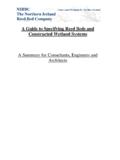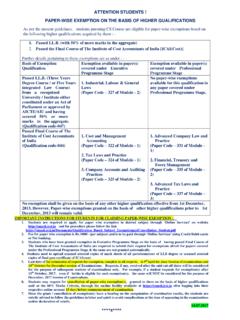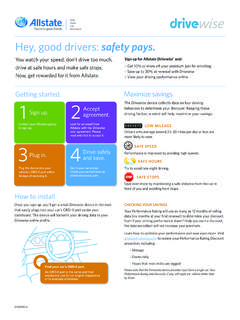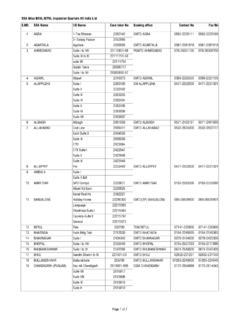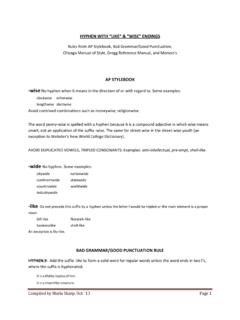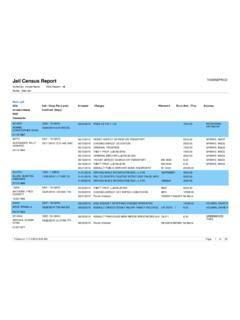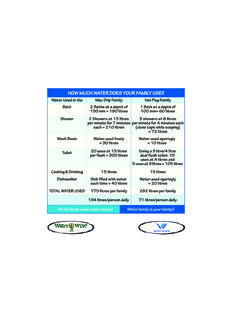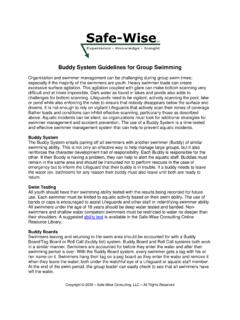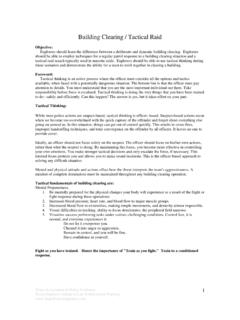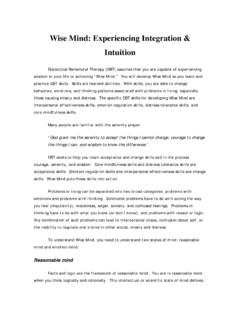Transcription of Wise use of Water within the Quarry Products Industry ...
1 Foreword Northern Ireland Environment Agency I very much welcome the publication of this guidance document wise use of Water in the Quarry Products Industry that has been jointly produced by the Northern Ireland Environment Agency (NIEA) and the Quarry Products Association of Northern Ireland (QPANI). The supply and use of aggregates and Quarry Products are essential for the provision of the buildings and infrastructure we need to allow our economy to grow. The Quarry Products Industry undoubtedly brings a wide range of benefits to society, but with this comes some risk of environmental damage to landscape, natural habitats, air and Water . We must all work together to minimise the adverse impacts of the supply and use of aggregates and Quarry Products . This guidance document is an important step towards protecting the environment through informing the Industry of the environmental and commercial benefits that will be delivered through pollution prevention, environmental monitoring and the wise use of Water .
2 The document is the product of constructive stakeholder engagement which was originally aimed at raising awareness within the Industry of the Abstraction and Impoundment (Licensing) Regulations (Northern Ireland) 2006 and to provide assistance in making applications. QPANI is to be congratulated for recognising the benefits that a wider guidance document will bring to the sector through enabling it to improve compliance with discharge consents issued under the Water (Northern Ireland) Order 1999, as well as enhancing the prevention of pollution and the management of Water at sites. The use of case studies brings the guidance to life by highlighting what others have achieved in the areas of consent compliance, pollution prevention and Water conservation. I am delighted that this Report will be available on both the NIEA and QPANI web sites, making it accessible to everyone working in the Industry . I believe that this is an excellent example of stakeholder participation which points the way for other sectors and that the adoption of the principles contained within the guidance will contribute to the introduction of Better Regulation.
3 DR ROY RAMSAY. Acting Chief Executive 2. Foreword Quarry Products Association NI. If aggregates are important in our everyday life, Water is even more so. Water management is a daily consideration in our Industry , with quarrying developments and operations impacted by groundwater, surface Water and discharges to the local freshwater environment. With increased pressure on businesses to consider the environment from customers, stakeholders and Government, due consideration is being given to this vital resource and is crucial to the sustainable supply of construction aggregates. Quarry Products Association NI (QPANI) members' recognise the potential their operations have to affect the environment and are committed to minimising and mitigating such effects, conscious of the need to carry out its work sensitively and responsibly. QPANI welcomes the assistance and knowledge from the NIEA Water Management Unit in producing the wise Use of Water Guidance document, and the opportunity to be able to work with our regulators in a cooperative and constructive fashion.
4 By being able to avoid or reduce adverse impacts on the Water environment, we can achieve our environmental objectives and make sustainable improvements in the Industry . Minimising waste and pollution risk saves money, it reduces operating costs and those companies with good environmental practices are at a competitive advantage. wise use of Water and implementing best practice is peace of mind for an operator, any negative publicity accompanyi ng poor management practice will damage a company's and our Industry 's image due to society's increasing environmental awareness. wise Use of Water in the Aggregates and Quarry Products Industry is a working document and it is our aim to share good practice within the Industry by gathering further case studies to the portfolio. It aims to provide an overview of the key issues and should be used as an aid by managers to review and improve upon an individual Quarry 's performance. Thank you to all who have contributed to the guidance and case studies; in particular Peter Close, Dale Shirlow and Ray Bennett, Claire Tannahill, Richard Coey from NIEA Water Management Unit and last but not least Laverne Bell, QPANI.
5 Johnny McQuillan Chairman, QPANI. 3. Contents Page Introduction 5. Water and the Quarry Environment 6. Sources of Water 7. A better understanding of Water in and around the Quarry 8. Water calculation tools 9 10. Steps to take for improved pollution prevention 11 13. Mitigation measures designed to reduce pollution 14. Oil and Chemicals 14 15. Silt and Cement 15 16. Design of Settling Ponds 17 19. Water Order Consents 20 22. The importance of our Natural Rivers 22. Biodiversity Gains 23 25. Local Case Studies of best practice 26 28. Conclusion 29. Annexes Annex A Legislative Drivers 30 31. Annex B Contact Details 32. Annex C Useful Links 33. Glossary 34 35. 4. wise use of Water within the Quarry Products Industry Introduction This guidance document has been jointly produced by the Northern Ireland Environment Agency (NIEA) and the Quarry Products Association Northern Ireland (QPANI). NIEA contributions have been made by staff from various disciplines. Contributions have been made by QPANI, Gordon Best (Regional Director) and his team.
6 This document aims to help Quarry managers to improve environmental performance on their sites. It is also intended to raise awareness and emphasise the importance of Water management. More specifically it aims to highlight: the benefits of carrying out a Water audit;. the benefits of reducing pollution risk by active pollution prevention; and the benefits of operating a pro-active maintenance and monitoring regime. Examples of best practice for Water conservation and reuse, effluent reduction, and effective treatment are also explored, and supported by local case studies. It is recommended that quarries develop and operate a system to manage Water throughout the whole site. This will include the Quarry boundary, the points where Water enters, where Water moves through the site, and at locations where Water is either utilised for processing or treated prior to discharge the cradle to grave approach. Having a better knowledge of Water sources, of how Water moves and transports sediment, and the principles of effective treatment, will provide managers with opportunities to minimise, reuse, and improve quality within their site.
7 If adopted, the overall impact the Quarry operation has upon the environment will also be reduced. This document has been written in 5 sections, each section focusing on a particular Water related topic. The first section focuses on Water and why it should be managed, the second section on pollution prevention, and the third on discharge consent compliance monitoring and maintenance, the fourth on the importance of Water for nature. The last section will summarise and draw out key recommendations. In summary, the key message emanating from this document is that effective Water management within the Quarry will deliver both environmental and commercial benefits to the businesses . 5. Water and the Quarry Environment Figure 1, Rivers and Quarries. As you can see from the above map, quarries in Northern Ireland are almost always located close to a watercourse. Water movement within quarries is a complex process. In most instances extraction occurs below or close to the Water table, which influences groundwater.
8 For all sites rainwater volumes need to be considered and managed. 6. Sources of Water You can see in figure 2, that Water is always in constant movement within the natural environment. Water in the air, ground, watercourses and the sea are continually interacting. Having a better knowledge of this process helps understand the movement of Water at the micro level how Water in quarries move and interact within the environment. (Figure 2. Hydrological Cycle and Groundwater Flows (source- ). Quarries source or receive Water from the natural environment in a number of ways: 1. Water which falls directly into Quarry voids as rainwater, 2. groundwater seepage, 3. run-off where the Quarry is bordered by higher adjacent land (this can have significant volumetric contributions, particularly during the wetter months). and 4. road run-off entering a site at the Quarry entrance, which in some instances can contribute unwelcome volumes. In addition to what nature can supply many quarries will also pump in Water .)
9 This additional source of Water ensures a constant supply of clean Water , which is necessar y for many Quarry product processes and/or for wash Water purposes. Pumped Water is mainly abstracted from boreholes but in some cases streams are 7. impounded and Water is pumped from the stream. One other final source of Water is potable Water although it is not commonly used for either production or wash Water . A Better Understanding of Water in and around the Quarry . In order to identify improvements or to better understand opportunities managers first need to know what Water processes are currently in place at the Quarry . A useful first step is to carry out a Water audit, as set out in the following 8 steps: 1. Investigate and understand how and where Water enters the Quarry 2. Estimate the total quantity of rainfall and seepage entering the Quarry , remember to allow for seasonal variation 3. Using pump records, calculate the amount of borehole and/or river Water that is being brought into the Quarry 4.
10 Collate the amount of potable Water used by the Quarry (only volumes used for operational purposes). 5. Calculate the volume of Water utilised for on-site production, washing and for dust suppression, assess the quality parameters for each use 6. Carryout an assessment of options to divert unwanted Water 7. Investigate the feasibility for intercepting and storing clean Water at a high ground position to best utilise a clean source of Water under gravity 8. Estimate the pumping and treatment costs associated with your site The following sections aim to help Quarry managers work through the above steps. Water Calculation Tools The following tools were jointly developed by NIEA and QPANI. They were designed to assist Quarry managers with the completion of Water abstraction licence application forms, and have been extensively used during 2007/08 for that purpose. For abstraction licensing purposes' the majority of quarries in Northern Ireland needed a methodology to help estimate the volume of groundwater which enters the Quarry as seepage and by pumping (if applicable).
